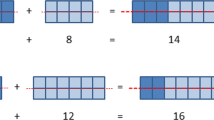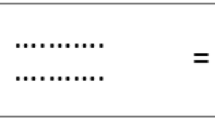Abstract
The purposes of this study are to investigate Turkish pre-service middle school mathematics teachers’ ability in conducting valid proofs for statements regarding numbers and algebra in terms of their year of enrollment in a teacher education program, to determine the proof methods used in their valid proofs, and to examine the reasons for their invalid arguments. A proof questionnaire containing three proof statements was administered to 115 pre-service middle school mathematics teachers in a large state university in Ankara, Turkey. The results showed that more than half of the pre-service teachers were able to conduct valid proofs for the given statements. In terms of year levels, it was seen that the seniors were the least successful group in conducting valid proofs for each statement. When pre-service teachers’ valid proofs were analyzed, it was concluded that mathematical induction and direct proof were the mostly used methods for the given statements. When pre-service teachers’ invalid arguments were analyzed, it was seen that “inserting numbers to verify the given statement” and “rewriting the givens in the statement” were the common reasons for stating invalid arguments.


Similar content being viewed by others
References
Alcock, L. J. & Weber, K. (2010). Undergraduates’ example use in proof construction: Purposes and effectiveness. Investigations in Mathematics Learning, 3, 1–22.
Almeida, D. (2000). A survey of mathematics undergraduates’ interaction with proof: Some implications for mathematics education. International Journal of Mathematical Education in Science and Technology, 31(6), 869–890.
Almeida, D. (2001). Pupils’ proof potential. International Journal of Mathematical Education in Science and Technology, 32(1), 53–60.
Altıparmak, K. & Öziş, T. (2005). An investigation upon mathematical proof and development of mathematical reasoning. Ege Education Journal, 6(1), 25–37.
Antonini, S. & Mariotti, A. M. (2008). Indirect proof: What is specific to this way of proving? ZDM-The International Journal of Mathematics Education, 40, 401–412.
Atwood, P.R. (2001). Learning to construct proofs in a first course on mathematical proof (Unpublished Doctoral Dissertation). Western Michigan University, Traverse City, MI.
Baylis, J. (1983). Proof—the essence of mathematics, part 1. International Journal of Mathematics Education and Science Technology, 14, 409–414.
Bell, A. W. (1976). A study of pupils’ proof-explanations in mathematical situations. Educational Studies in Mathematics, 7, 23–40.
Bieda, K. (2010). Enacting proof in middle school mathematics: Challenges and opportunities. Journal for Research in Mathematics Education, 41, 351–382.
Blanton, M., Stylianou, D.A., & David, M. (2003). The nature of scaffolding in undergraduate students’ transition to mathematical proof. In N.A. Pateman, B.J. Dougherty & J. Zilliox (Eds.), Proceedings of the 27th PME International Conference (Vol. 2, pp. 113–120). Honalulu, Hawaii: ERIC.
Bleiler, S. K., Thompson, D. R. & Krajčevski, M. (2014). Providing written feedback on students’ mathematical arguments: Proof validations of prospective secondary mathematics teachers. Journal of Mathematics Teacher Education, 17(2), 105–127.
Brown, S. A. (2014). On skepticism and its role in the development of proof in the classroom. Educational Studies in Mathematics, 86(3), 311–335.
Davis, P. J. & Hersh, R. (1981). The mathematical experience. Boston, MA.
Dickerson, D.S. (2008). High school mathematics teachers’ understandings of the purposes of mathematical proof (Unpublished Doctoral Dissertation). Syracuse University, Syracuse, NY.
Fitzgerald, J. F. (1996). Proof in mathematics education. Journal of Education, 178(1), 35–45.
Fraenkel, J. R. & Wallen, N. E. (2005). How to design and evaluate research in education (6th ed.). Boston, MA.
Gibson, D. (1998). Students’ use of diagrams to develop proofs in an introductory analysis course. Students’ proof schemes. In E. Dubinsky, A. Schoenfeld, & J. Kaput (Eds.), Research in collegiate mathematics education, III (pp.284–307). New York, NY: AMS.
Goetting, M. (1995). The college students’ understanding of mathematical proof (Unpublished Doctoral Dissertation). University of Maryland, College Park, MD.
Hanna, G. (2000). Proof, explanation and exploration: An overview. Educational Studies in Mathematics, 44, 5–23.
Hanna, G. & de Villiers, M. (2008). ICMI study 19: Proof and proving in mathematics education. ZDM-The International Journal of Mathematics Education, 40(2), 1–8.
Harel, G. & Sowder, L. (1998). Students’ proof schemes: Results from exploratory studies. CBMS Issues in Mathematics Education, 7, 234–283.
Harel, G. & Sowder, L. (2007). Toward a comprehensive perspective on proof. In F. Lester (Ed.), Second handbook of research on mathematics teaching and learning (pp. 435–458). Reston, VA.
Healy, L. & Hoyles, C. (2000). A study of proof conceptions in algebra. Journal for Research in Mathematics Education, 31(4), 396–428.
Heinze, A. & Reiss, K. (2003). Reasoning and proof: Methodological knowledge as a component of proof competence. In M.A. Mariotti (Ed.), Proceedings of the Third Conference of the European Society for Research in Mathematics Education (pp.1--10). Bellaria, Italy: ERME.
Iannone, P. & Inglis, M. (2010) Self efficacy and mathematical proof: Are undergraduate students good at assessing their own proof production ability? In S. Brown, S. Larsen, K. Keene, & K. Marrongelle (Eds.), Proceedings of the 13th Conference on Research in Undergraduate Mathematics Education. North Carolina: Raleigh.
Jahnke, H. N. (2007). Proofs and hypotheses. ZDM-The International Journal of Mathematics Education, 39(1–2), 79–86.
Jones, K. (1997). Student teachers’ conceptions of mathematical proof. Mathematics Education Review, 9, 21–32.
Knapp, J. (2005). Learning to prove in order to prove to learn. Retrieved in May 2013 from http://mathpost.asu.edu/~sjgm/issues/2005_spring/SJGM_knapp.pdf.
Knuth, E. (1999). The nature of secondary school mathematics teachers’ conceptions of proof (Unpublished doctoral dissertation). University of Colorado, Boulder, CO.
Ko, Y. Y. (2010). Mathematics teachers’ conceptions of proof: Implications for educational research. International Journal of Science and Mathematics Education, 8(6), 1109–1129.
Ko, Y. Y. & Knuth, E. (2009). Undergraduate mathematics majors’ writing performance producing proofs and counterexamples about continuous functions. The Journal of Mathematical Behavior, 28(1), 68–77.
Krantz, S.G. (2007). The history and concept of mathematical proof. Retrieved in May 2013 from www.math.wustl.edu/~sk/eolss.pdf.
Mariotti, M.A. (2006). Proof and proving in mathematics education. In A. Gutiérrez & P. Boero (Eds.), Handbook of research on the psychology of mathematics education, (pp. 173–204), Rotterdam, The Netherlands: Sense.
Martin, W. G. & Harel, G. (1989). Proof frames of preservice elementary teachers. Journal for Research in Mathematics Education, 20(1), 41–51.
Mejia-Ramos, J.P. & Inglis, M. (2009). Argumentative and proving activities in mathematics education research. In F.-L. Lin, F.-J. Hsieh, G. Hanna & M. de Villiers (Eds.), Proceedings of the ICMI Study 19 conference: Proof and Proving in Mathematics Education (Vol. 2, pp. 88–93). [New York, NY]: Springer.
Moore, R. C. (1994). Making the transition to formal proof. Educational Studies in Mathematics, 27, 249–266.
Morris, D.W. & Morris, J. (2009). Proofs and concepts: The fundamentals of abstract mathematics. Alberta, Canada: University of Lethbridge.
National Council of Teacher of Mathematics (2000). Principles and standard for school mathematics. Reston, VA: National Council of Teacher of Mathematics.
Overton, W. F. (1990). Reasoning, necessity, and logic: Developmental perspectives. Hillsdale, NJ: L. Erlbaum Associates.
Palla, M., Potari, D. & Spyrou, P. (2011). Secondary school students’ understanding of mathematical induction: Structural characteristics and the process of proof construction. International Journal of Science and Mathematics Education, 10(5), 1023–1045.
Raman, M. (2003). What are they and how can they help us understand how people view proof? Educational Studies in Mathematics, 52, 319–325.
Recio, A. M. & Godino, J. D. (2001). Institutional and personal meanings of mathematical proof. Educational Studies in Mathematics, 48(1), 83–89.
Riley, K.J. (2003). An investigation of prospective secondary mathematics teachers’ conceptions of proof and refutations (Unpublished doctoral dissertation). Montana State University, Bozeman, MT.
Ross, K. A. (1998). Doing and proving: The place of algorithms and proof in school mathematics. American Mathematical Monthly, 3, 252–255.
Saeed, R.M. (1996). An exploratory study of college students’ understanding of mathematical proof and the relationship of this understanding to their attitudes toward mathematics (Unpublished doctoral dissertation). Ohio University, Athens, OH.
Schoenfeld, A. H. (1994). What do we know about mathematics curricula? Journal of Mathematical Behavior, 13(1), 55–80.
Segal, J. (2000). Learning about mathematical proof: Conviction and validity. Journal of Mathematical Behavior, 18, 191–210.
Shipley, A.J. (1999). An investigation of collage students’ understanding of proof construction when doing mathematical analysis proofs (Unpublished doctoral dissertation). University of American, Washington, DC.
Stylianides, A. J. (2007). The notion of proof in the context of elementary school mathematics. Educational Studies in Mathematics, 65(1), 1–20.
Stylianides, A. J. & Ball, D. L. (2008). Understanding and describing mathematical knowledge for teaching: Knowledge about proof for engaging students in the activity of proving. Journal of Mathematics Teacher Education, 11, 307–332.
Stylianides, A. & Stylianides, G. (2009). Proof constructions and evaluations. Educational Studies in Mathematics, 72, 237–253.
Stylianides, A. J., Stylianides, G. J. & Philippou, G. N. (2004). Undergraduate students’ understanding of the contraposition equivalence rule in symbolic and verbal contexts. Educational Studies in Mathematics, 55, 133–162.
Stylianides, A.J., Stylianides, G.J. & Philippou, G.N. (2005). Prospective teachers’ understanding of proof: What if the truth set of an open sentence is broader than that covered by the proof? In H. L. Chick & J. L. Vincent (Eds.), Proceedings of the 29th Annual Conference of the International Group for the Psychology of Mathematics Education (vol. 4, pp. 241–248). Melbourne, Australia, PME.
Stylianides, G. J., Stylianides, A. J. & Philippou, G. N. (2007). Preservice teachers’ knowledge of proof by mathematical induction. Journal of Mathematics Teacher Education, 10, 145–166.
Tall, D. (1989). The nature of mathematical proof. Mathematics Teaching, 127, 28–32.
VanSpronsen, H.D. (2008). Proof processes of novice mathematics proof writers (Unpublished Doctoral Dissertation). University of Montana, Missoula, MT.
Velleman, D.J. (2006). How to prove it. Cambridge, England: Cambridge University Press.
Weber, K. (2001). Student difficulty in constructing proofs. The need for strategic knowledge. Educational Studies in Mathematics, 48(1), 101–119.
Weber, K. (2008). How mathematicians determine if an argument is a valid proof. Journal for Research in Mathematics Education, 39(4), 431–459.
Weber, K. (2010). Mathematics’ majors perceptions of conviction, validity, and proof. Mathematical Thinking and Learning, 12, 306--336.
Author information
Authors and Affiliations
Corresponding author
Rights and permissions
About this article
Cite this article
Demiray, E., Işıksal Bostan, M. An Investigation of Pre-service Middle School Mathematics Teachers’ Ability to Conduct Valid Proofs, Methods Used, and Reasons for Invalid Arguments. Int J of Sci and Math Educ 15, 109–130 (2017). https://doi.org/10.1007/s10763-015-9664-z
Received:
Accepted:
Published:
Issue Date:
DOI: https://doi.org/10.1007/s10763-015-9664-z




